Causes and Demonstration of Thermal Stress in Castings Made from Gray Iron
Abstract
1. Introduction
- Thermal tension (cracking and crushing);
- Oxidation of the surface (scaling losses and singeing);
- Growth (a permanent increase in volume).
2. Thermal Tension
- (a)
- The modulus of elasticity E is a characteristic attribute of each material. The reference values for cast iron are as follows:
- (b)
- The coefficient of linear expansion α is a physical parameter that depends on the type of metal and composition of a casting. It specifies the expansion of materials caused by a temperature change (or shrinkage during cooling). Its value is determined by the following formula:
- (c)
- The temperature gradient Δt is very significant in connection with the thermal stress, and even its maximum value (size) as well as its time pattern. The maximum value Δt is determined by operating conditions—the required heating temperature. It cannot be controlled (reduced) in most cases in practice. However, the heating rate is important, which should be as low as possible. Thermal shocks, i.e., rapid heating and cooling of castings, are very undesirable. The change and the maximum value of the temperature gradient, especially in cyclical heating, mainly depend on
- The thermal conductivity of the material;
- Thermal capacity of the material,
- Casting construction (wall thickness).
- (d)
- Thermal conductivity λ [W.m−1.K−1] significantly affects the formation of temperature gradients and their size, and thus the resulting tension inversely. It is very diverse in different metals. It also decreases in the casting materials (micro-shrinkages, pores, bubbles, etc.). It is also different for the structural components of cast irons, as shown in Table 2. Temperature conductivity decreases with increasing temperature (melting up to 30% of the original value). It decreases at about 8 ÷ 10% at a temperature of 500 °C. The dependence of specific thermal conductivity on temperature is given by
- (e)
- The specific thermal capacity c [kJ.kg−1.K−1] (specific heat) is an important physical value associated with the formation and course of thermal processes. The values of individual metals and their alloys are very different, as shown in Table 3 [22]. A higher value is preferable with regard to the thermal stress of castings, because at the same heat input, it reduces the thermal rate and temperature gradients and, finally, the tension in the walls of castings.
- (f)
- The ductility of the material A [%], which determines plastic characteristics of the material, is very low (0.2 ÷ 0.8%) in GJL, but it is slightly increased with temperature. This reduces the resulting tension due to the causes of plastic deformation, especially at temperatures exceeding ΔtK, e.g., the area of flexible–plastic deformation (for GJL the critical temperature (range) ΔtK = 380 ÷ 410 °C) [23].
- (g)
- The construction of castings in the context of thermal stress and hence lifetime under operating conditions is an important factor, as well as the physical properties of the material and exploitation conditions (stress mode). The most important factor is the determination (calculation) of the optimum wall thickness in each section (cross-section) of the casting, depending on the size and time course of thermal stress. While increasing the wall thickness of castings (elements) increases the mechanical strength, it also increases the temperature gradient Δt, i.e., the temperature difference between the heated and cold (outside) wall. Today, in practice, there are various ways of calculating the optimum wall thickness for certain castings for determined procedures of thermal stress. Particular cases are the cast iron molds for steel casting or casting under pressure. The following formula, for example, calculates the optimal wall thickness hs of heavy steel molds [1]:
3. Numerical Procedures to Determine Thermal Stresses
4. Surface Oxidation (Scaling)
5. Cast Iron Growth
6. Cast Iron Composition
- (a)
- Unalloyed cast iron (hematite, fire-resistant) is characterized by a high content of C (over 3.8%), a reduced content of Si (1.2 ÷ 1.8%), and low contents of harmful accompanying elements (S, P, Pb, As, and Sb). Their production from pure raw iron (hematite) is made to replace the iron used for the production of GJS. Synthetic cast iron is less suitable, even if it is sufficiently “clean”, due to the high content of N (above 60 ppm), which increases the proportion of pearlite. A higher Mn content is desirable (0.7 ÷ 1.2%)—thermally stabilized pearlite [29].
- (b)
- The most appropriate alloying elements are Cr (0.3 ÷ 2%), Ni (0.1 ÷ 1.7%), and Mo (up to 0.3%), which significantly increase the thermal strength. They are suitable for about 850 °C, and they show many times lower scaling (scaling loss), growth, and a high strength at increased temperatures (thanks to Mo).
7. Discussion
8. Conclusions
Author Contributions
Funding
Data Availability Statement
Conflicts of Interest
References
- Lickfett, H. Gussproduktion 2010-globale Trends. Giesserei 99 2012, 2012, 154–157. [Google Scholar]
- Miskiewicz, R.; Volniak, R. Practical application of the industry 4.0 concept in a steel company. Sustainability 2020, 12, 5776. [Google Scholar] [CrossRef]
- Leitner, M.; Garb, C.; Riedler, M.; Grün, F. Microstructural assessment of thermal damage in cast iron brake discs. Eng. Fail. Anal. 2020, 110, 104412. [Google Scholar] [CrossRef]
- Liu, D.; Liu, Y.; Wu, Z.; Yang, Y. Thermal fatigue behaviors of compacted graphite iron and flake graphite iron. Materials 2022, 15, 1387. [Google Scholar] [CrossRef]
- Mohammadi, A.; Alizadeh, M.; Kazemi, S. Investigation of thermal fatigue behavior in centrifugally cast Ni-resist austenitic cast iron. Mater. Sci. Eng. A 2020, 788, 139500. [Google Scholar] [CrossRef]
- Elmquist, L.; Diószegi, A.; Björklind, T.O. On the formation of primary austenite and eutectic cells in grey iron and its effect on the thermal gradients during solidification. IOP Conf. Ser. Mater. Sci. Eng. 2019, 529, 012020. [Google Scholar] [CrossRef]
- Rashid, A.K.; Khalaf, A.; Al-Sahib, N.; Hanna, A. Modeling and simulation of brake disk-pad system using advanced finite element analysis. Eng. Technol. J. 2021, 39, 1821–1833. [Google Scholar]
- Guo, Y.; Li, Y.; Wang, X.; Guo, Z. Thermal shock behavior of gray cast iron under alternate cooling-heating loads. Materials 2020, 13, 856. [Google Scholar] [CrossRef]
- Grandviewresearch. Available online: https://www.grandviewresearch.com/industry-analysis/iron-casting-market-report (accessed on 28 April 2025).
- The Leading Metals Information Provider. Available online: https://news.metal.com/newscontent/101787233/the-challenge-of-cast-iron-today-and-its-future-development-trend (accessed on 28 April 2025).
- Anwar, M.Y. A study on thermal cracking of cast iron. In Proceedings of the Pakistan Engineering Congress, 70th Annual Session Proceedings, Punjab, Pakistan, 23 October 2006; pp. 414–422. Available online: http://pecongress.org.pk/images/upload/books/Paper677.pdf (accessed on 25 May 2025).
- Moonesan, M.; Honarbakhsh raouf, A.; Madah, F.; Habibollah, Z.A. Effect of alloying elements on thermal shock resistance of gray cast iron. J. Alloys Compd. 2012, 503, 226–231. [Google Scholar] [CrossRef]
- Manesh, A.A.I.; Segerlind, L.J. Simulation of heat transfer and stress analysis of continuous casting. Arch. Appl. Mech. 1991, 61, 393–403. [Google Scholar] [CrossRef]
- Maijer, D.; Cockcroft, S.; Jacot, A. Modeling of microstructure and residual stress in cast iron calender rolls. Metall. Mater. Trans. A 2000, 31, 1201–1211. [Google Scholar] [CrossRef]
- Bumbálek, L. Zbytková napětí určovaná pomocí Barkhausenova šumu. Strojírenská technologie 2004, IX, 11–15. [Google Scholar]
- Joshi, A.; Baxevanakis, K.P.; Silberschmidt, V.V. High-Temperature Creep of Cast Irons. In Solid Mechanics, Theory of Elasticity and Creep; Altenbach, H., Mkhitaryan, S.M., Hakobyan, V., Sahakyan, A.V., Eds.; Springer: Cham, Switzerland, 2023; Volume 185. [Google Scholar] [CrossRef]
- Shaha, S.K.; Haque, M.M. Simulation of Heat Flow in Computational Method and Its Verification on the Structure and Property of Gray Cast Iron. Am. J. Appl. Sci. 2010, 7, 795–799. [Google Scholar] [CrossRef]
- Chen, R.; Xu, Q.; Liu, B.; Zhang, J. In situ observation of graphite morphology changes during thermal cycling of gray cast iron. Mater. Charact. 2020, 167, 110494. [Google Scholar] [CrossRef]
- Ekström, M.; Jonsson, S. High-temperature mechanical and fatigue properties of cast alloys intended for use in exhaust manifolds. Mater. Sci. Eng. A 2014, 616, 78–87. [Google Scholar] [CrossRef]
- Venkatesan, K.; Subramanian, R. Analysis of mechanical and thermal properties of cast iron with boron carbide composites. Metall. Mater. Trans. A 2022, 53, 660–670. [Google Scholar]
- Maj, M. The Formation of the Strength of Castings including Stress and Strain Analysis. Materials 2024, 17, 2484. [Google Scholar] [CrossRef]
- Jelč, I. Výroba Hutníckych a Ťažkých Odliatkov; VŠT: Košice, Slovakia, 1983. [Google Scholar]
- Futas, P.; Pribulova, A.; Pokusova, M.; Junakova, A. Liatiny, Vlastnosti, Výroba, Použitie; TUKE: Košice, Slovakia, 2020. [Google Scholar]
- Magmasoft 4.4: Magmairon Module, Simulation of Microstructural Modeling in Cast Iron. 2005. Available online: https://www.magmasoft.de/en/solutions/cast-iron/ (accessed on 20 March 2025).
- Kim, H.S. Analysis of thermal behavior during equal channel multi-angular pressing by the 3-dimensional finite volume method. Mater. Sci. Eng. A 2009, 503, 130–136. [Google Scholar] [CrossRef]
- Zeman, P.; Mádl, J. Simulace doformací v obrobku softwarem AdvantEdge 3.6. Strojírenská technoogie 2002, VII, 23–27. [Google Scholar]
- Novacast. Release of NovaFlow&Solid 6.4. 2025. Available online: https://www.novacast.se/news/release-of-novaflowsolid-6-4/ (accessed on 1 February 2021).
- Lekakh, S.N.; Bofah, A.; Godlewski, L.A.; Li, M. Effect of Micro-Structural Dispersity of SiMo Ductile Iron on High Temperature Performance during Static Oxidation. Metals 2022, 12, 661. [Google Scholar] [CrossRef]
- Futas, P.; Pástor, M.; Pribulova, A. Analysis of the possibilities of reducing the levels of residual stresses in casting produced from synthetic cast iron. Heliyon 2024, 10, e33623. [Google Scholar] [CrossRef] [PubMed]
- Wang, C.; Li, P.; Ma, Y.; Liu, Z. Multi-scale simulation of microstructural evolution and thermal stress development in gray cast iron brake discs. Int. J. Heat Mass Transf. 2022, 182, 121960. [Google Scholar] [CrossRef]
- Kiani, M.; Nasehi, A.; Khalilpour, H.; Saffarzadeh, M. A physics-based model to predict thermal fatigue life of compacted graphite iron engine blocks. Eng. Fail. Anal. 2020, 115, 104599. [Google Scholar] [CrossRef]
- Hasanlu, M.; Shirvani, F.; Mahdian, S. Experimental thermal fatique crack on brake disc of heavy vehicle. Mater. Science Eng. Appl. 2025. [Google Scholar] [CrossRef]
- Xiangbin, C.; Qiao, X.Z.; Jingui, Y.; Xinfeng, Y. Effect of compositional changes and heat treatment on microstructure and mechanical properties of gray cast iron. J. Mater. Res. Technol. 2025, 35, 5336–5352. [Google Scholar] [CrossRef]
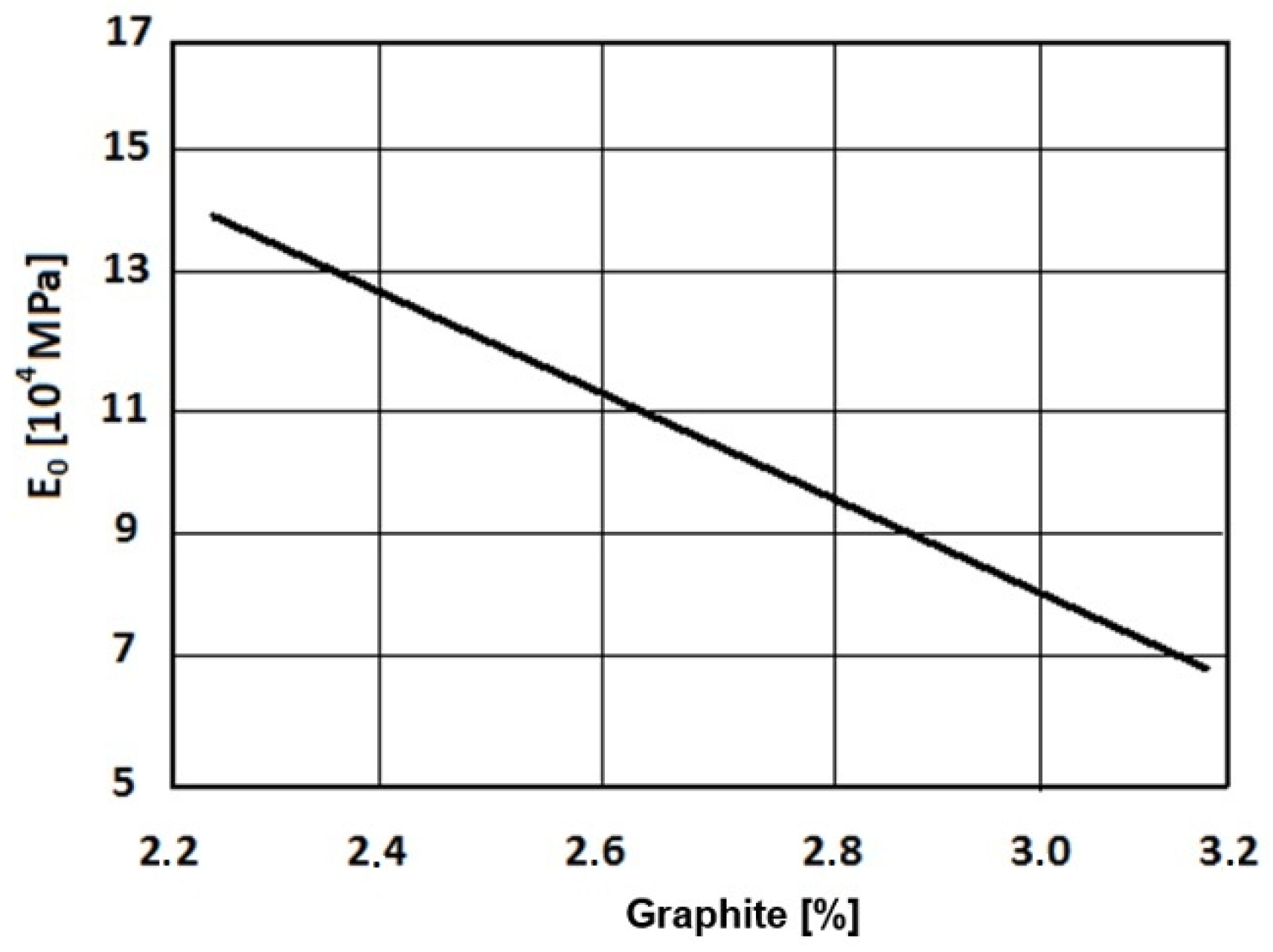
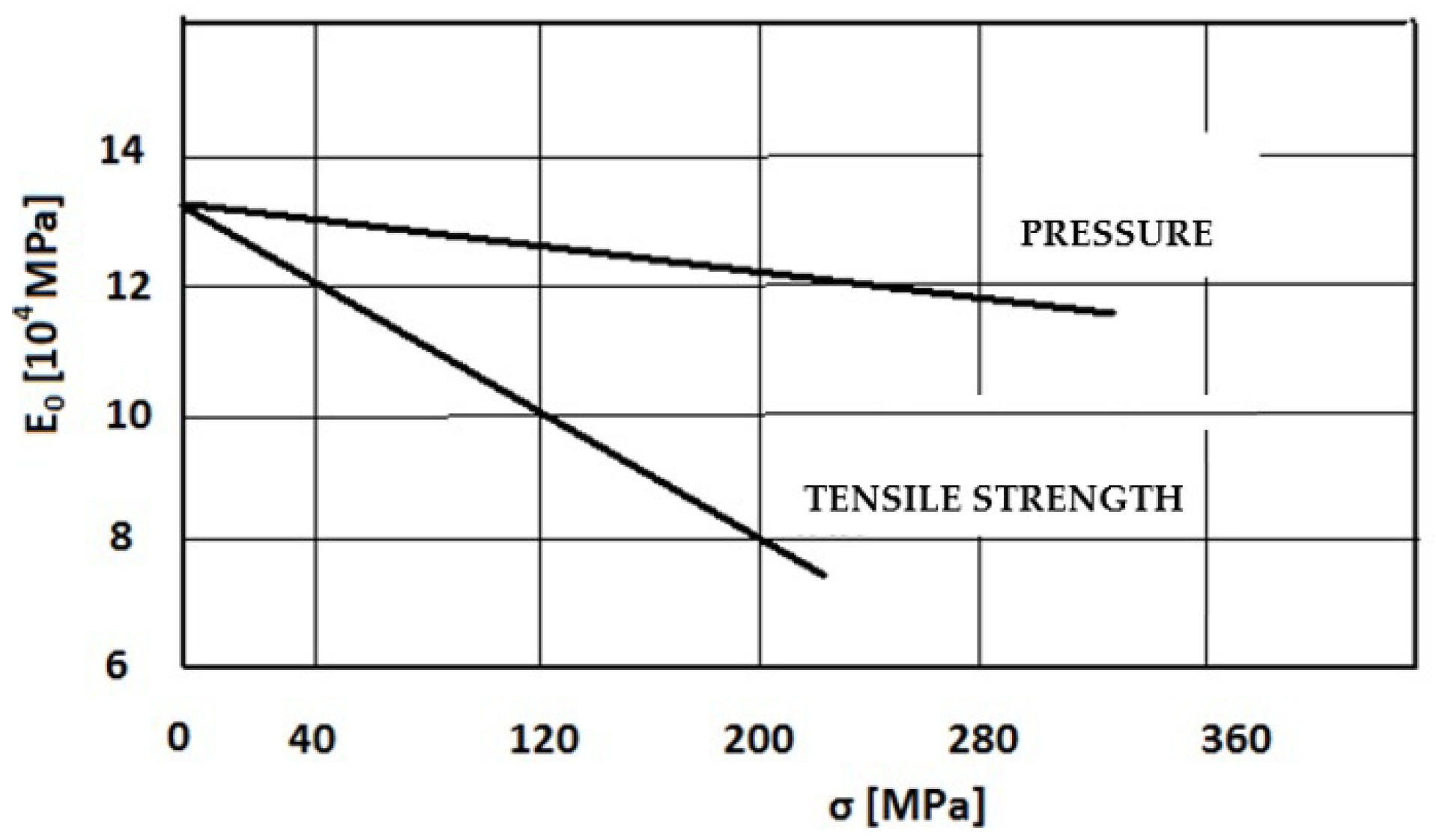
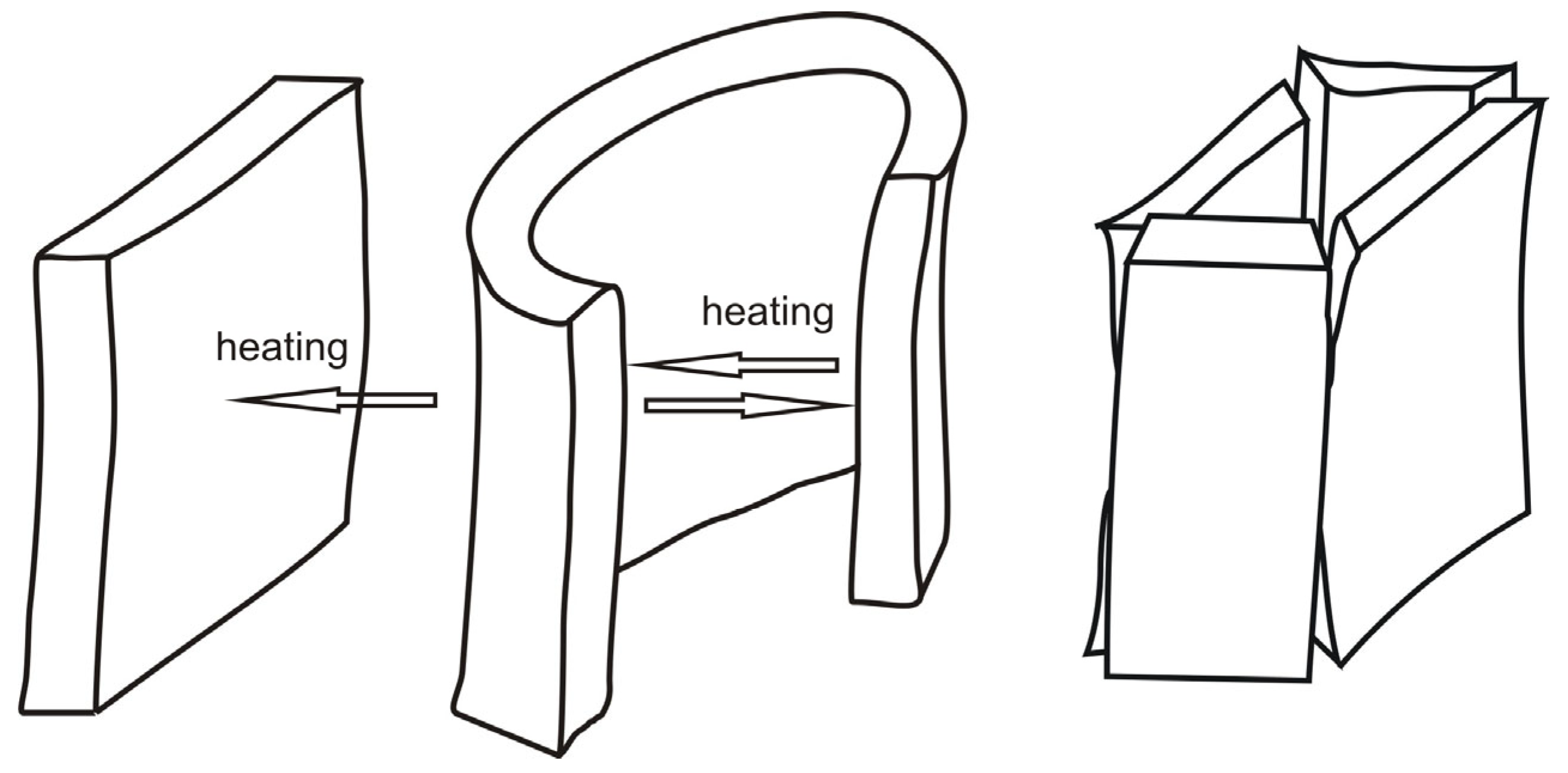
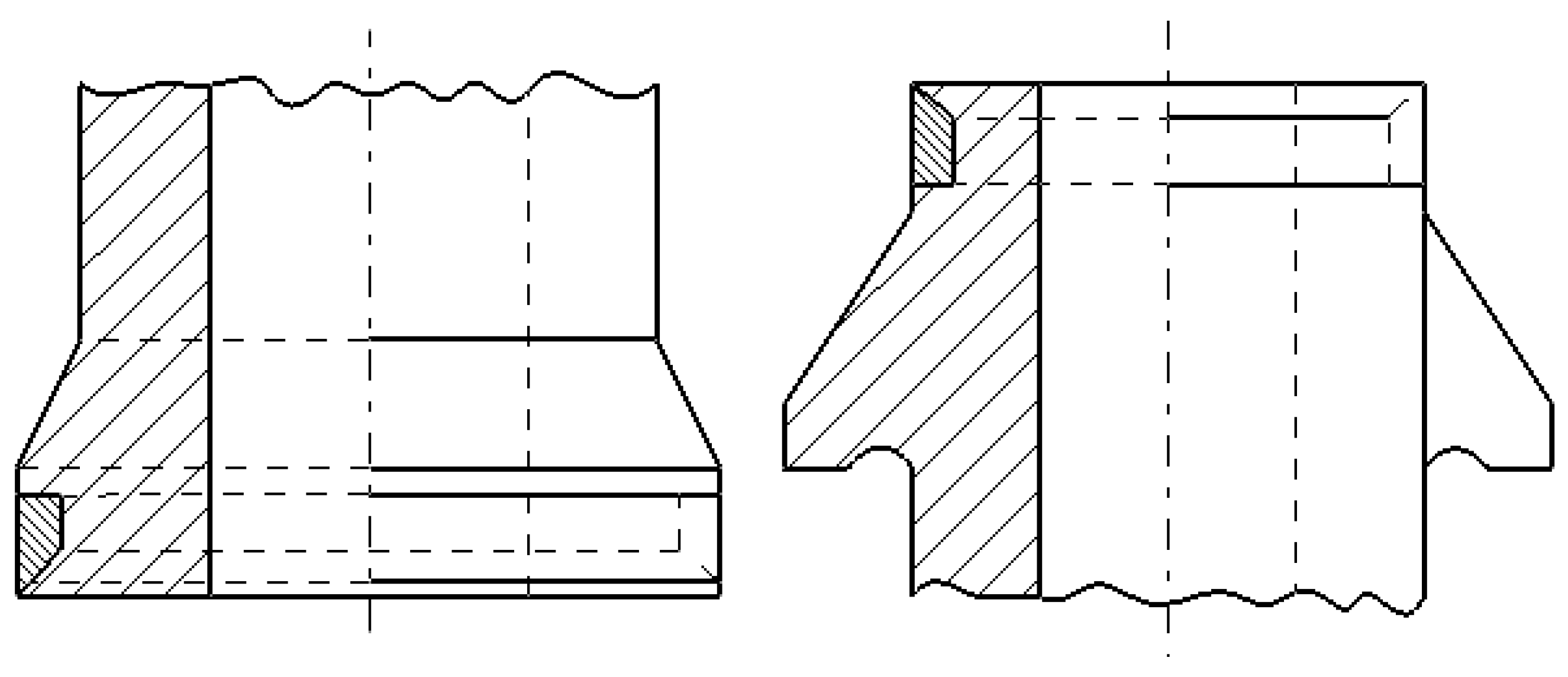
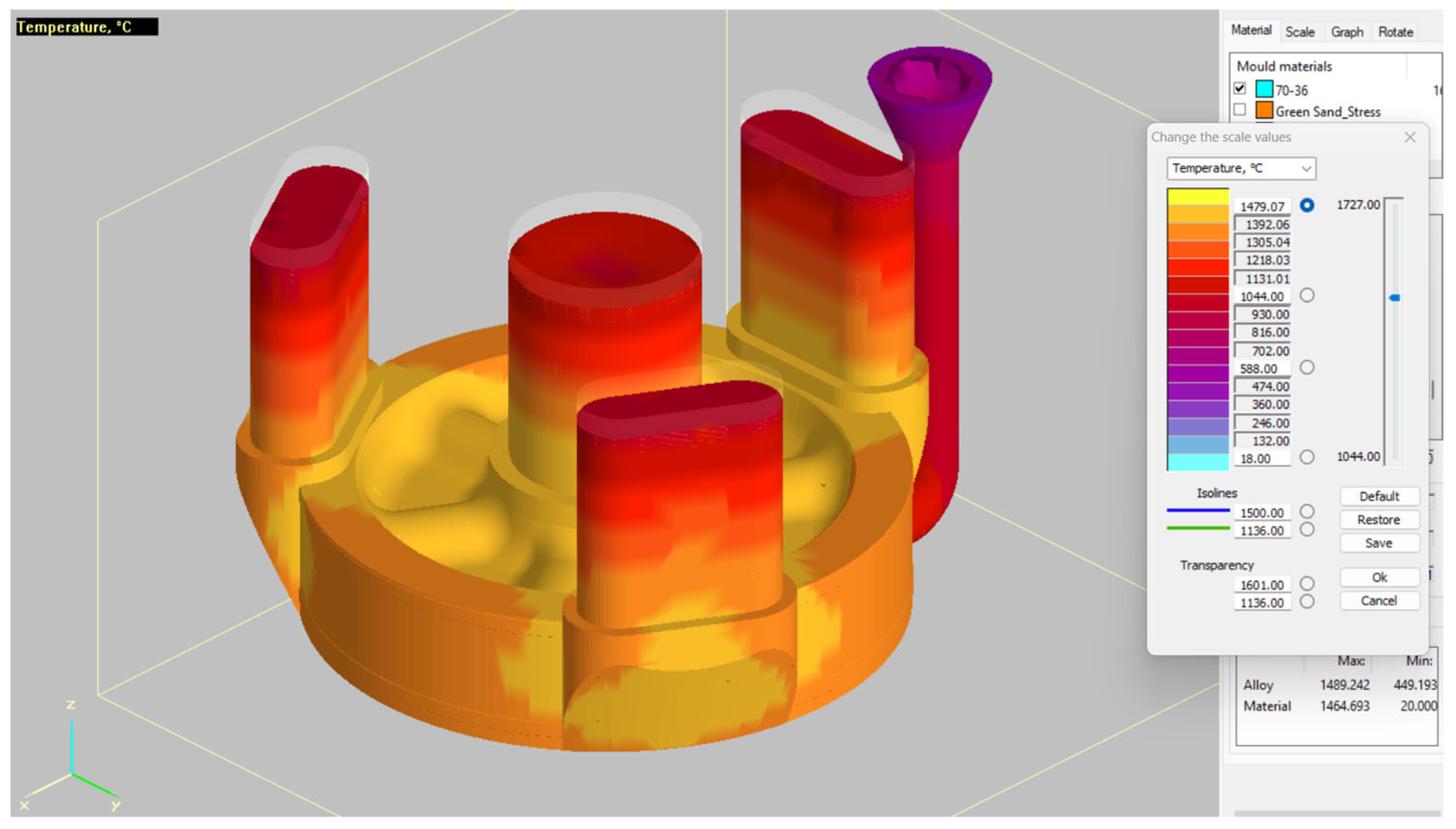
| Material | The Coefficient of Linear Expansion α. 10−6 K−1 at Δt | |||
|---|---|---|---|---|
| 20–100 | 20–200 | 20–400 | 20–600 | |
| GJL | 8.6 | 8.8 | 11.3 | 13.2 |
| GJS | - | - | 12.5 | - |
| Steel 0.1% C | 11.6 | 12.6 | 13.6 | 14.6 |
| Steel 0.3% C | 12.6 | 13.9 | 15.6 | 15.8 |
| Pure iron | 11.5 | 11.7 | 11.8 | 12.0 |
| Aluminium | 23 | - | - | - |
| Zinc | 30 | - | - | - |
| Copper | 16.8 | - | - | - |
| Material | Fe | Zn | Al | Cu | LLG | LGG | Ferrite | Graphite |
|---|---|---|---|---|---|---|---|---|
| λt [W.m−1.K−1] | 59 | 113 | 225 | 385 | 45 ÷ 80 | 30 ÷ 40 | 76 | 90 ÷ 375 |
| Metal | Fe | Zn | Al | Cu | GJL | GJS | Ferrite | Pearlite | Graphite |
|---|---|---|---|---|---|---|---|---|---|
| c [kJ.kg−1.K−1] | 0.50 | 0.39 | 0.89 | 0.39 | 0.46 ÷ 0.54 | 0.515 | 0.46 | 0.52 | 0.84 |
Disclaimer/Publisher’s Note: The statements, opinions and data contained in all publications are solely those of the individual author(s) and contributor(s) and not of MDPI and/or the editor(s). MDPI and/or the editor(s) disclaim responsibility for any injury to people or property resulting from any ideas, methods, instructions or products referred to in the content. |
© 2025 by the authors. Licensee MDPI, Basel, Switzerland. This article is an open access article distributed under the terms and conditions of the Creative Commons Attribution (CC BY) license (https://creativecommons.org/licenses/by/4.0/).
Share and Cite
Futas, P.; Pribulova, A.; Petrik, J.; Blasko, P.; Solc, M.; Brzezinski, M. Causes and Demonstration of Thermal Stress in Castings Made from Gray Iron. Thermo 2025, 5, 21. https://doi.org/10.3390/thermo5030021
Futas P, Pribulova A, Petrik J, Blasko P, Solc M, Brzezinski M. Causes and Demonstration of Thermal Stress in Castings Made from Gray Iron. Thermo. 2025; 5(3):21. https://doi.org/10.3390/thermo5030021
Chicago/Turabian StyleFutas, Peter, Alena Pribulova, Jozef Petrik, Peter Blasko, Marek Solc, and Marcin Brzezinski. 2025. "Causes and Demonstration of Thermal Stress in Castings Made from Gray Iron" Thermo 5, no. 3: 21. https://doi.org/10.3390/thermo5030021
APA StyleFutas, P., Pribulova, A., Petrik, J., Blasko, P., Solc, M., & Brzezinski, M. (2025). Causes and Demonstration of Thermal Stress in Castings Made from Gray Iron. Thermo, 5(3), 21. https://doi.org/10.3390/thermo5030021










